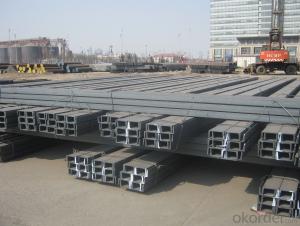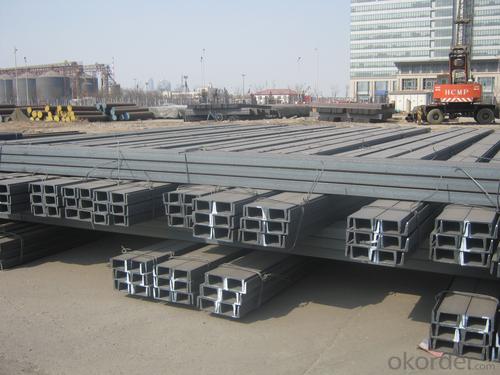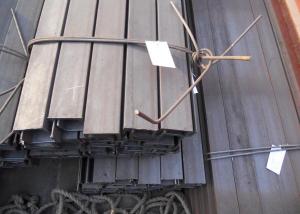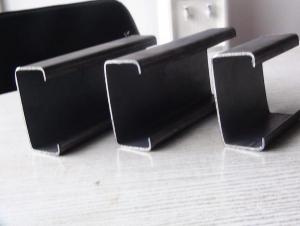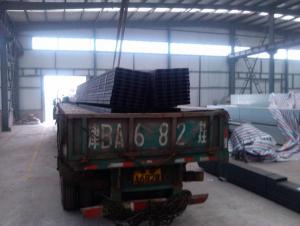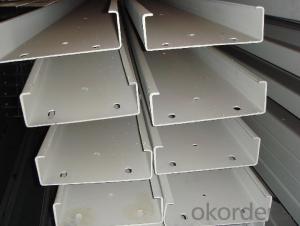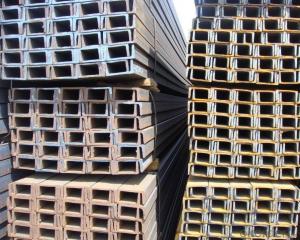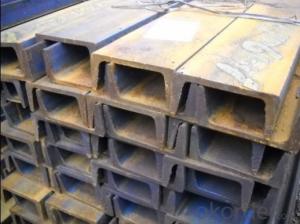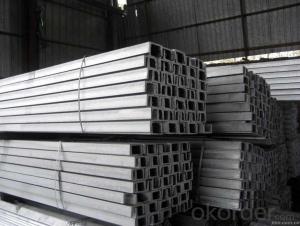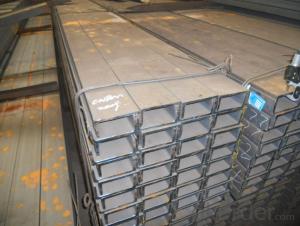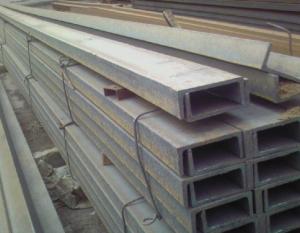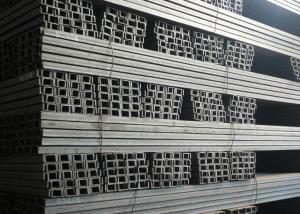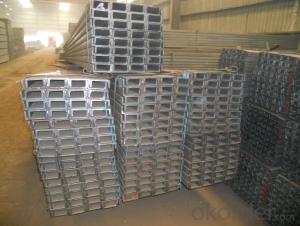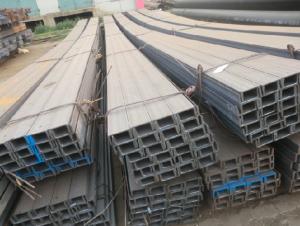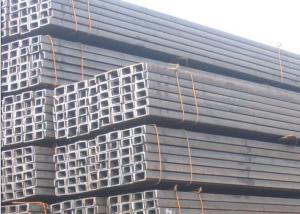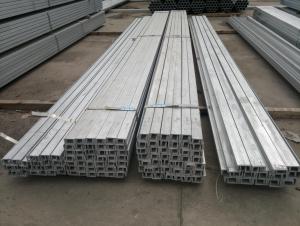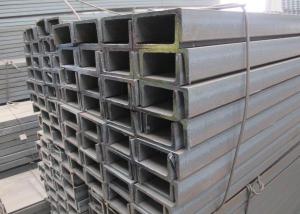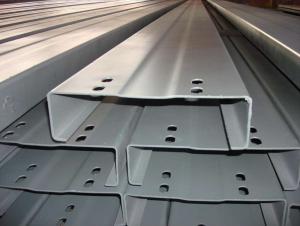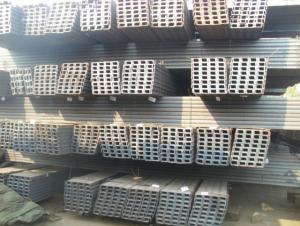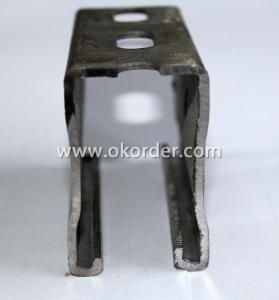Japanese Standard Steel Channel
- Loading Port:
- China Main Port
- Payment Terms:
- TT OR LC
- Min Order Qty:
- -
- Supply Capability:
- -
OKorder Service Pledge
OKorder Financial Service
You Might Also Like
Specifications of Hot Rolled Channel Steel:
1. We are definitely speciallizing in manufacturing and supplying channel steel as per japanese standard, which is characterised with high mechanical strength and competitive prices.
Original Place | Tangshan, China | Brand Name | UINDA |
Standard | JIS G3192 : 1990 | ||
Material Grade | SS540 | ||
Sizes | 50mm to 200mm | ||
Sales Volume/Year | 3000MT | ||
Destination Area | Middle East, Africa, Southeast Asia | ||
2. The mechanical property of Hot Rolled Channel Steel in the table-1:
Grade | Yield Strength,N/mm² | Extension Strength N/mm² | |||
Thickness of Steel,mm | |||||
≦16 | >16-≦40 | >40-≦100 | >100 | ||
SS540 | ≧400 | ≧390 | - | - | ≧540 |
Table-1
3. The chemical composition of Hot Rolled Channel Steel as per SS540 in the table-2
Grade | Yield Strength,N/mm² | Extension Strength N/mm² | |||
Thickness of Steel,mm | |||||
≦16 | >16-≦40 | >40-≦100 | >100 | ||
SS540 | ≧400 | ≧390 | - | - | ≧540 |
Table-2
*If you would like to get our price, please inform us the size, standard/material and quantity. Thank you very much for your attention.
- Q: Are steel channels prone to rusting?
- Yes, steel channels are prone to rusting. Steel is primarily made of iron, and when exposed to moisture or oxygen, it can undergo a chemical reaction known as oxidation, which leads to the formation of rust. Rusting weakens the steel structure, making it more susceptible to corrosion and eventual failure. Therefore, steel channels need to be protected from moisture and other corrosive elements using appropriate coatings or treatments to prevent rust formation and prolong their lifespan.
- Q: How do steel channels contribute to sustainable construction?
- Steel channels contribute to sustainable construction in several ways. Firstly, steel is a highly durable material that can withstand extreme weather conditions and has a long lifespan, reducing the need for frequent replacements. Additionally, steel channels are often made from recycled materials, reducing the demand for raw resources and minimizing waste. Steel is also highly recyclable, making it a sustainable choice as it can be repurposed at the end of its lifespan. Furthermore, steel channels are lightweight, which reduces the energy required for transportation and installation. Overall, steel channels offer strength, durability, recyclability, and reduced environmental impact, making them a sustainable choice for construction projects.
- Q: What are the different methods of protecting steel channels from rust?
- There are several methods available to protect steel channels from rust. 1. Galvanization: This is a widely used method where the steel channels are coated with a layer of zinc. The zinc acts as a sacrificial layer, protecting the steel from corrosion. Galvanized steel channels have high resistance to rust even in harsh environments. 2. Powder coating: This method involves applying a dry powder onto the surface of the steel channels and then heating it to create a protective layer. Powder coating provides excellent corrosion resistance and also offers a variety of color options. 3. Paint or primer: Applying a layer of paint or primer to the steel channels can help protect them from rust. The paint creates a barrier between the steel and the surrounding environment, preventing moisture and oxygen from reaching the metal surface. 4. Epoxy coating: Epoxy coatings are often used in industrial settings to protect steel channels from corrosion. These coatings offer excellent adhesion, chemical resistance, and durability, providing long-term protection against rust. 5. Stainless steel: Using stainless steel channels is an effective way to prevent rust. Stainless steel contains a high percentage of chromium, which forms a passive protective layer on the surface, making it highly resistant to corrosion. 6. VCI (Volatile Corrosion Inhibitors): VCI films or papers can be used to wrap or line steel channels. These materials release vapor-phase corrosion inhibitors that protect the metal surface from rust. 7. Cathodic protection: This method involves connecting the steel channels to a sacrificial anode, such as zinc or magnesium. The anode corrodes instead of the steel, protecting it from rust. It is important to select the appropriate method based on the specific environment, budget, and desired level of protection. Regular maintenance and inspection of the steel channels are also crucial to identify any signs of corrosion and take necessary measures to prevent further damage.
- Q: Can steel channels be used for roof trusses?
- Indeed, roof trusses can make use of steel channels. In construction, steel channels are frequently employed due to their robustness and longevity. It is possible to produce steel channels with precise measurements, facilitating exceptional support for roof trusses. Furthermore, steel channels possess resistance against warping, splitting, and shrinking, thereby establishing their dependability as a suitable option for roof trusses.
- Q: Are steel channels cost-effective compared to other materials?
- Yes, steel channels are generally considered to be cost-effective compared to other materials. Steel is a widely available and relatively inexpensive material, making steel channels a cost-effective choice for various construction and manufacturing applications. Additionally, steel channels offer excellent strength and durability, allowing them to withstand heavy loads and harsh conditions. This durability translates to long-term cost savings as steel channels require less maintenance and replacement compared to other materials. Furthermore, steel is highly recyclable, making it an environmentally friendly option. While the initial cost of steel channels may be slightly higher compared to some other materials, the long-term cost-effectiveness and numerous advantages make steel channels a popular choice in various industries.
- Q: Can steel channels be used for framing?
- Certainly! Framing can be achieved using steel channels. These channels, known for their versatility, are extensively utilized in construction for multiple objectives, one of which is framing. Their robustness and longevity make them the ideal choice for providing structural reinforcement to buildings and other structures. By effortlessly welding or bolting steel channels together, a sturdy framework can be established to support walls, roofs, and floors. Due to their stability and resistance against bending and warping, steel channels are commonly employed in industrial, commercial, and residential construction ventures. Moreover, their availability in various sizes and thicknesses allows for flexibility in design and construction.
- Q: How do steel channels perform in high-vibration environments?
- Steel channels are commonly used in high-vibration environments due to their excellent resilience and durability. Their solid construction helps absorb and distribute vibrations, minimizing the risk of structural damage or failure. Additionally, steel channels can be reinforced or modified with additional supports to further enhance their performance in such environments.
- Q: What are the guidelines for steel channel installation in corrosive environments?
- To ensure the longevity and effectiveness of steel channels in corrosive environments, it is crucial to adhere to several essential guidelines: 1. Material selection: Opt for a steel material specifically engineered to withstand corrosive environments. Stainless steel is often an ideal choice due to its high corrosion resistance. Additionally, carefully consider the grade of stainless steel that best suits the specific corrosive substances present in the environment. 2. Surface preparation: Thoroughly prepare the surface of the steel channels before installation. This entails removing any existing rust or corrosion, meticulously cleaning the surface, and applying a protective coating or treatment to enhance corrosion resistance. 3. Protective coatings: Apply appropriate protective coatings to the steel channels to prevent corrosion. This may involve using paints, epoxy coatings, or galvanizing. Ensure that the chosen coating is compatible with the corrosive environment and offers long-term protection. 4. Proper drainage: Design the installation in a manner that facilitates proper drainage of any corrosive substances that may come into contact with the steel channels. This helps minimize the accumulation of corrosive agents and reduces the risk of corrosion. 5. Avoid contact with dissimilar metals: Steer clear of direct contact between the steel channels and dissimilar metals, as this can trigger galvanic corrosion. If contact cannot be avoided, employ suitable insulating materials or coatings to separate the metals and prevent galvanic corrosion. 6. Regular maintenance: Conduct regular inspections and maintenance on the steel channels to identify any signs of corrosion or damage. Promptly address any issues to prevent further deterioration and ensure the continued effectiveness of the installation. 7. Follow industry standards and recommendations: Familiarize yourself with pertinent industry standards, guidelines, and recommendations for installing steel channels in corrosive environments. These resources provide valuable insights into best practices and ensure compliance with safety and performance requirements. It is crucial to seek guidance from corrosion control specialists or engineers who specialize in this field. Their expertise will ensure that the guidelines are tailored to the specific corrosive environment and intended application of the steel channels.
- Q: Standard size and price of 12# channel steel...
- According to the 05 building system quota, the specification 120*53*5.5 (unit mm), the unit price is 4739.90 yuan per ton.
- Q: Can steel channels be used for shelving systems?
- Yes, steel channels can be used for shelving systems. They provide strong support and durability, making them ideal for heavy loads and storage applications. Additionally, steel channels can be easily customized and adjusted to fit specific shelving needs.
Send your message to us
Japanese Standard Steel Channel
- Loading Port:
- China Main Port
- Payment Terms:
- TT OR LC
- Min Order Qty:
- -
- Supply Capability:
- -
OKorder Service Pledge
OKorder Financial Service
Similar products
Hot products
Hot Searches
Related keywords
